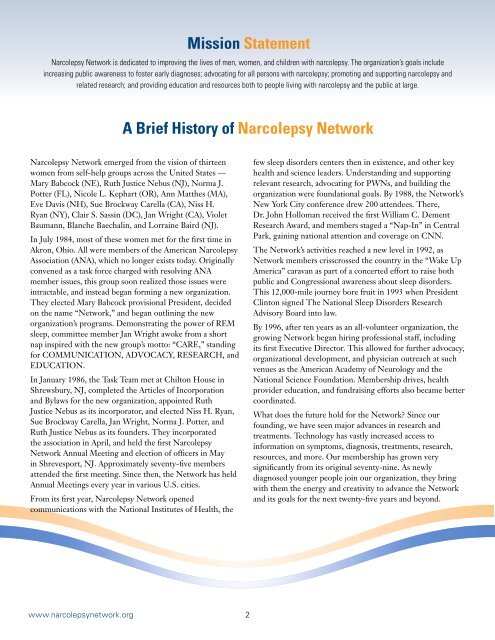Narcolepsy Network, Inc. 2011 Annual Report
Narcolepsy Network, Inc. 2011 Annual Report
Narcolepsy Network, Inc. 2011 Annual Report
Create successful ePaper yourself
Turn your PDF publications into a flip-book with our unique Google optimized e-Paper software.
Mission Statement<br />
<strong>Narcolepsy</strong> <strong>Network</strong> is dedicated to improving the lives of men, women, and children with narcolepsy. The organization’s goals include<br />
increasing public awareness to foster early diagnoses; advocating for all persons with narcolepsy; promoting and supporting narcolepsy and<br />
related research; and providing education and resources both to people living with narcolepsy and the public at large.<br />
A Brief History of <strong>Narcolepsy</strong> <strong>Network</strong><br />
<strong>Narcolepsy</strong> <strong>Network</strong> emerged from the vision of thirteen<br />
women from self-help groups across the United States —<br />
Mary Babcock (NE), Ruth Justice Nebus (NJ), Norma J.<br />
Potter (FL), Nicole L. Kephart (OR), Ann Matthes (MA),<br />
Eve Davis (NH), Sue Brockway Carella (CA), Niss H.<br />
Ryan (NY), Clair S. Sassin (DC), Jan Wright (CA), Violet<br />
Baumann, Blanche Baechalin, and Lorraine Baird (NJ).<br />
In July 1984, most of these women met for the first time in<br />
Akron, Ohio. All were members of the American <strong>Narcolepsy</strong><br />
Association (ANA), which no longer exists today. Originally<br />
convened as a task force charged with resolving ANA<br />
member issues, this group soon realized those issues were<br />
intractable, and instead began forming a new organization.<br />
They elected Mary Babcock provisional President, decided<br />
on the name “<strong>Network</strong>,” and began outlining the new<br />
organization’s programs. Demonstrating the power of REM<br />
sleep, committee member Jan Wright awoke from a short<br />
nap inspired with the new group’s motto: “CARE,” standing<br />
for COMMUNICATION, ADVOCACY, RESEARCH, and<br />
EDUCATION.<br />
In January 1986, the Task Team met at Chilton House in<br />
Shrewsbury, NJ, completed the Articles of <strong>Inc</strong>orporation<br />
and Bylaws for the new organization, appointed Ruth<br />
Justice Nebus as its incorporator, and elected Niss H. Ryan,<br />
Sue Brockway Carella, Jan Wright, Norma J. Potter, and<br />
Ruth Justice Nebus as its founders. They incorporated<br />
the association in April, and held the first <strong>Narcolepsy</strong><br />
<strong>Network</strong> <strong>Annual</strong> Meeting and election of officers in May<br />
in Shrevesport, NJ. Approximately seventy-five members<br />
attended the first meeting. Since then, the <strong>Network</strong> has held<br />
<strong>Annual</strong> Meetings every year in various U.S. cities.<br />
From its first year, <strong>Narcolepsy</strong> <strong>Network</strong> opened<br />
communications with the National Institutes of Health, the<br />
www.narcolepsynetwork.org<br />
2<br />
few sleep disorders centers then in existence, and other key<br />
health and science leaders. Understanding and supporting<br />
relevant research, advocating for PWNs, and building the<br />
organization were foundational goals. By 1988, the <strong>Network</strong>’s<br />
New York City conference drew 200 attendees. There,<br />
Dr. John Holloman received the first William C. Dement<br />
Research Award, and members staged a “Nap-In” in Central<br />
Park, gaining national attention and coverage on CNN.<br />
The <strong>Network</strong>’s activities reached a new level in 1992, as<br />
<strong>Network</strong> members crisscrossed the country in the “Wake Up<br />
America” caravan as part of a concerted effort to raise both<br />
public and Congressional awareness about sleep disorders.<br />
This 12,000-mile journey bore fruit in 1993 when President<br />
Clinton signed The National Sleep Disorders Research<br />
Advisory Board into law.<br />
By 1996, after ten years as an all-volunteer organization, the<br />
growing <strong>Network</strong> began hiring professional staff, including<br />
its first Executive Director. This allowed for further advocacy,<br />
organizational development, and physician outreach at such<br />
venues as the American Academy of Neurology and the<br />
National Science Foundation. Membership drives, health<br />
provider education, and fundraising efforts also became better<br />
coordinated.<br />
What does the future hold for the <strong>Network</strong>? Since our<br />
founding, we have seen major advances in research and<br />
treatments. Technology has vastly increased access to<br />
information on symptoms, diagnosis, treatments, research,<br />
resources, and more. Our membership has grown very<br />
significantly from its original seventy-nine. As newly<br />
diagnosed younger people join our organization, they bring<br />
with them the energy and creativity to advance the <strong>Network</strong><br />
and its goals for the next twenty-five years and beyond.


